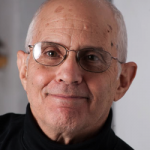Taking Refuge in the Big Picture
Getty/AnnaElizabethPhotography
“One quick, effective way to counter the fear, pessimism, and brooding despair that so easily overwhelms us in these days of non-stop alarming news is to shift to a Big Picture perspective.”
One quick, effective way to counter the fear, pessimism, and brooding despair that so easily overwhelms us in these days of non-stop alarming news is to shift to a Big Picture perspective. We usually perceive reality from the metaphorical ground floor, if not through a basement window. When we ascend to higher levels, our vista expands and we see things afresh. We notice details we couldn’t see before. We see what’s lurking and what’s on the way. We see better how the pieces interact, and we can comprehend events in a broader, more spacious context. This is what happens when we mentally enlarge our vision and enfold the specifics of the moment into a cosmological or theological frame.
In difficult times, some people turn to the Big Picture of a faith tradition, perhaps to comforting phrases such as: “It is God’s will” or “We are in God’s hands.” Or they recall one of the soothing aphorisms commonly attributed to the Bible (even though they can’t be found there): “The Lord moves in mysterious ways, His wonders to perform,” or “This too shall pass”—an assertion of the impermanence of all phenomena that Buddhists and Hindus would be quick to affirm, along with Teresa of Avila, who said: “Let nothing disturb you. Let nothing dismay you. All things pass. God never changes.” And many a Christian and non-Christian resonates with the assurance of the 14th Century mystic, Julian of Norwich: “All shall be well, and all shall be well, and all manner of thing shall be well.”
Others in search of a Big Picture shift to a saint’s-eye perspective. They ask how Jesus, or Buddha, or their favorite guru or spiritual mentor would see the situation that is making them angry, fearful, or bitter. Of course, we may never know how those we venerate would actually react to the circumstances that vex us, but merely asking the question, imagining an answer, and attempting—however feebly—to put the template into practice has a way of lifting us up.
These days, of course, many spiritual voyagers locate higher ground in the Eastern concept of karma. We’ve all heard karmic theory expressed in colloquial terms—every action has an equal and opposite reaction; we reap what we sow; what goes around comes around, etc. Karma presents a system of cosmic justice that sounds less like theology than a scientific principle or a law of nature, like gravity. In the Big Picture of karma, justice prevails in the long run; good is rewarded and wrong is penalized, even though it may not seem that way through our ordinary lens.
If you prefer a scientific perspective, the vastness of the known universe might do the trick. It may not take more than gazing at the night sky or looking at images from the Hubbell telescope and contemplating the fact that what you’re seeing actually occurred many light years ago. In the Big Picture of time and space, the worrisome present is a speck of dust on the garment of Infinity. Even a relatively brief historical view can do the job. Reflecting on the horrors of the past reveals that, by most measures of human misery, the common feeling that things have never been worse is illusory. One can readily find evidence for Martin Luther King Jr.’s optimistic statement that “the arc of the moral universe is long, but it bends toward justice.”
Another possible vantage point is the possibility that our present turmoil is a symptom of a collective cleansing, like the discomfort that arises when the body rids itself of toxins. That view can be dismissed as New Age drivel, of course, but maybe we are, as W.B. Yeats put it, slouching toward Bethlehem to be born. Maybe, as many believe, chaos and destruction are needed to eliminate poisons and clear the way for a healthier, more progressive future.
There is comfort in an expansive perspective, and all it takes is to step into your mental elevator and press the button for Cosmic Penthouse. The view from the top is not unlike the healing revelation all of humanity shared when we saw the first images of Earth from space, when the boundaries that wreak so much havoc were nowhere to be seen, and the sound of bombs and guns could not be heard, and troublesome human beings were not even specks.
But there is a downside to taking refuge in a Big Picture: it can trick you into false complacency and escapism. I’ve seen too many spiritual people dwell in the assumption that a positive future is pre-ordained because their version of a beneficent Higher Power has things under control. Well, that may be so, but what if that Higher Power needs human beings to help out? What if the cosmic plan, whether it was designed by a benevolent God or set in motion by an indifferent set of evolutionary laws, requires our active participation? What if the arc of the moral universe bends toward justice only if we help bend it by doing good? So, by all means, let’s take refuge in an elevated perspective whenever we can. But let’s then come back down and pitch in. Our humble offerings to the greater Good, however small they may seem, might very well be essential. And if they’re not? Well, we’ll feel a lot better for having made them.


